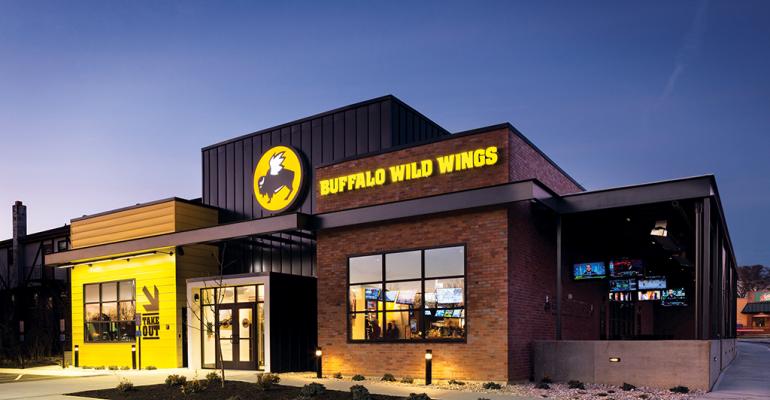Franchising, retail, business

09/02/2017
Refranchising plan is a response to shareholder pressure
Buffalo Wild Wings Inc. plans to sell at least 60 restaurants to franchisees and improve margins at others as it works to reinvigorate sales and profits amid mounting shareholder pressure.
Buffalo Wild Wings said during an earnings call on Tuesday that it has identified about 10 percent of company-owned restaurants for refranchising. The company owns 631 of the chain’s more than 1,200 locations.
The locations identified for refranchising are in markets where Buffalo Wild Wings doesn’t have enough locations to succeed.
“As a result, we view these areas as better suited to be run by our franchisees or others with greater local scale and resources,” Alexander Ware, Buffalo Wild Wings’ CFO, said during the call. “These are markets that we will evaluate selling as part of our first optimization effort.”
Ware said Buffalo Wild Wings is reviewing advisors to assist in the potential sales.
Executives from the Minneapolis-based casual-dining operator also suggested that they are open to further sales of company locations in the future if the sale of the initial restaurants works out. But they wouldn’t provide a goal in terms of the percentage of units it wants to own and operate, and said they would continue building and buying locations in markets where returns are strong.
“We will continually evaluate our portfolio, and we will pursue the appropriate strategies whether to own units, sell units or intensively improve the performance of units — not to reach a predetermined ownership target, but rather to increase shareholder value by taking into account market conditions and performance potential,” Ware said.
Buffalo Wild Wings is “at the beginning of the process,” Ware said, and refranchising is unlikely to have a major impact in 2017. He suggested the bulk of restaurant sales would come in 2018.
The effort comes amid growing pressure from an activist shareholder for Buffalo Wild Wings to make major changes.
Earlier this week, shareholder Marcato Capital Management LP nominated four people to Buffalo Wild Wings’ board of directors, and has been critical of the company’s capital spending strategies. In particular, Marcato has pushed Buffalo Wild Wings to stop buying franchisees, as it has done in recent years, and sell company locations to operators.
It also comes as Buffalo Wild Wings’ sales and profits have struggled. Fourth-quarter net earnings fell 38.2 percent, while same-store sales declined 4 percent, the company said on Tuesday.
On the earnings call, executives did, however, suggest that Buffalo Wild Wings is generating more traffic early this year. Improvements in traffic have been “modestly positive” so far in the first quarter. They said efforts such as a 15-minute lunch guarantee called Fast Break Lunch, as well as Half Price Wing Tuesdays, have gained traction.
On Wednesday, investors appeared on board with Buffalo Wild Wings’ moves and its improved traffic. The company’s stock rose more than 2 percent in Wednesday morning trading, after initially falling as much as 5 percent in after-hours trading Tuesday evening, after the earnings release.
In addition to refranchising efforts, Buffalo Wild Wings executives said they have aggressive plans to improve the performance of other company-owned locations.
“We’ve identified a second set of restaurants where our focus is to quickly improve unit performance,” Ware said. The plans involve restaurant-specific strategies to improve sales and margins.
And Buffalo Wild Wings is evaluating its cost structure in order to generate restaurant-level margins of 20 percent. Ware said the company is working to identify tasks that can be “improved, retooled or moved out of the restaurants,” such as moving some prep work to suppliers and establishing call centers for dial-in orders.
The company is also analyzing field support, home office spending and procurement efforts to improve profits.
But executives said the biggest impacts on margins come from same-store sales and chicken-wing prices. Wing prices in the fourth quarter were $1.99 a pound, nearly 10 percent higher than last year. And cost of labor increased 90 basis points, to 31.8 percent of sales.
Executives suggested that the difficult restaurant environment has been brought on by a shift in consumer demand toward more delivery, and because of growing competition.
“We’re all aware of the challenging environment, variety-seeking consumers, a proliferation of restaurant choices and competition from delivery,” Buffalo Wild Wings CEO Sally Smith said during the call.
Buffalo Wild Wings launched a 100-restaurant pilot of third-party delivery in December. COO James Schmidt said average check for delivery is 30 percent higher than it is for traditional takeout. The sales are “incremental,” he said, although the company is working on alternatives to improve the service’s profits — the higher sales from delivery orders come with lower margins thanks to delivery fees.
“We’ve got great plans to react to and capture that trend,” Schmidt said.
Contact Jonathan Maze at Questo indirizzo email è protetto dagli spambots. È necessario abilitare JavaScript per vederlo.
Follow him on Twitter: @jonathanmaze
Fonte:http://www.nrn.com/sales-trends/buffalo-wild-wings-sell-least-60-locations